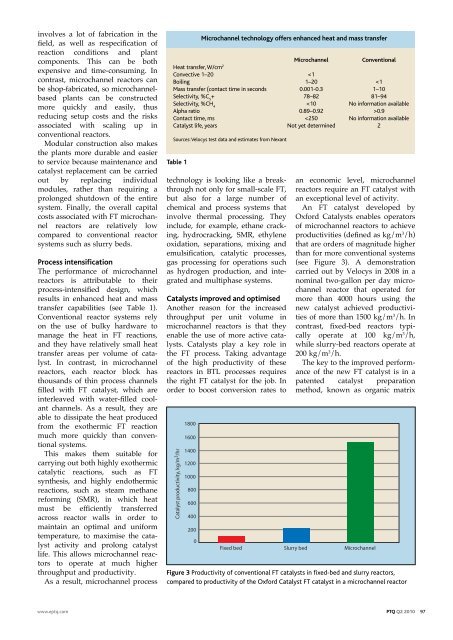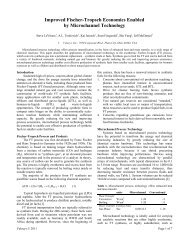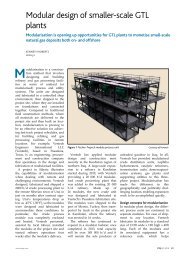Microchannel reactors in fuel production - Oxford Catalysts Group
Microchannel reactors in fuel production - Oxford Catalysts Group
Microchannel reactors in fuel production - Oxford Catalysts Group
You also want an ePaper? Increase the reach of your titles
YUMPU automatically turns print PDFs into web optimized ePapers that Google loves.
<strong>in</strong>volves a lot of fabrication <strong>in</strong> the<br />
field, as well as respecification of<br />
reaction conditions and plant<br />
components. This can be both<br />
expensive and time-consum<strong>in</strong>g. In<br />
contrast, microchannel <strong>reactors</strong> can<br />
be shop-fabricated, so microchannelbased<br />
plants can be constructed<br />
more quickly and easily, thus<br />
reduc<strong>in</strong>g setup costs and the risks<br />
associated with scal<strong>in</strong>g up <strong>in</strong><br />
conventional <strong>reactors</strong>.<br />
Modular construction also makes<br />
the plants more durable and easier<br />
to service because ma<strong>in</strong>tenance and<br />
catalyst replacement can be carried<br />
out by replac<strong>in</strong>g <strong>in</strong>dividual<br />
modules, rather than requir<strong>in</strong>g a<br />
prolonged shutdown of the entire<br />
system. F<strong>in</strong>ally, the overall capital<br />
costs associated with FT microchannel<br />
<strong>reactors</strong> are relatively low<br />
compared to conventional reactor<br />
systems such as slurry beds.<br />
Process <strong>in</strong>tensification<br />
The performance of microchannel<br />
<strong>reactors</strong> is attributable to their<br />
process-<strong>in</strong>tensified design, which<br />
results <strong>in</strong> enhanced heat and mass<br />
transfer capabilities (see Table 1).<br />
Conventional reactor systems rely<br />
on the use of bulky hardware to<br />
manage the heat <strong>in</strong> FT reactions,<br />
and they have relatively small heat<br />
transfer areas per volume of catalyst.<br />
In contrast, <strong>in</strong> microchannel<br />
<strong>reactors</strong>, each reactor block has<br />
thousands of th<strong>in</strong> process channels<br />
filled with FT catalyst, which are<br />
<strong>in</strong>terleaved with water-filled coolant<br />
channels. As a result, they are<br />
able to dissipate the heat produced<br />
from the exothermic FT reaction<br />
much more quickly than conventional<br />
systems.<br />
This makes them suitable for<br />
carry<strong>in</strong>g out both highly exothermic<br />
catalytic reactions, such as FT<br />
synthesis, and highly endothermic<br />
reactions, such as steam methane<br />
reform<strong>in</strong>g (SMR), <strong>in</strong> which heat<br />
must be efficiently transferred<br />
across reactor walls <strong>in</strong> order to<br />
ma<strong>in</strong>ta<strong>in</strong> an optimal and uniform<br />
temperature, to maximise the catalyst<br />
activity and prolong catalyst<br />
life. This allows microchannel <strong>reactors</strong><br />
to operate at much higher<br />
throughput and productivity.<br />
As a result, microchannel process<br />
<strong>Microchannel</strong><br />
conventional<br />
Heat transfer, W/cm 2<br />
Convective 1–20











